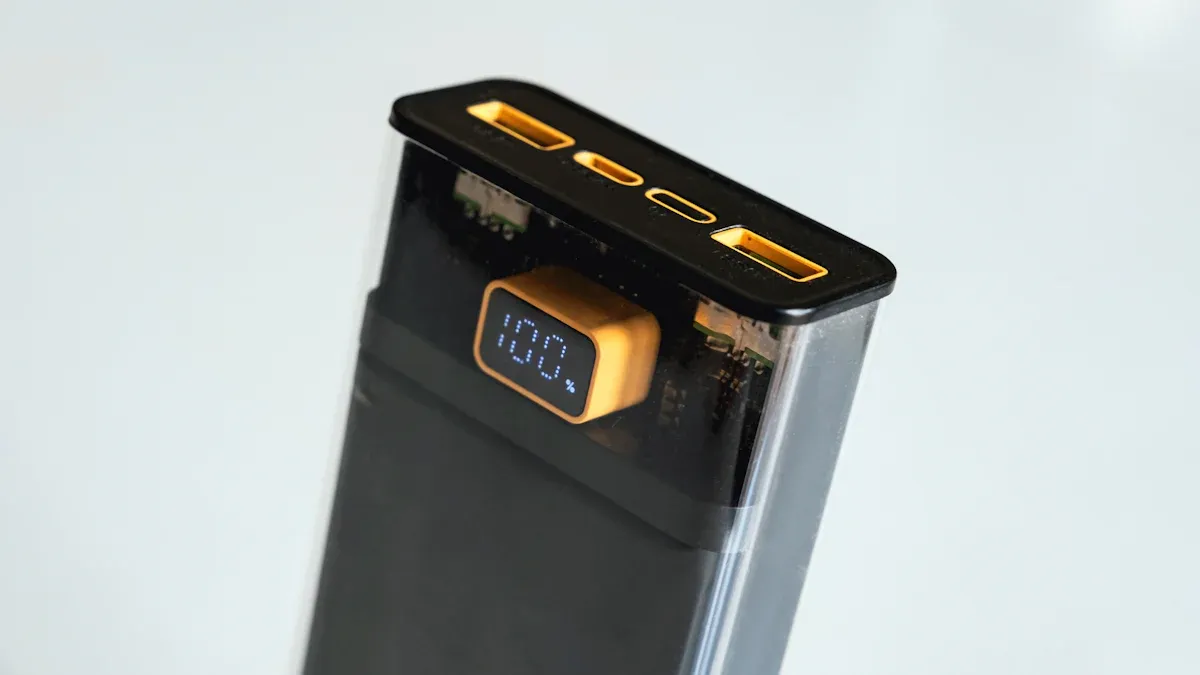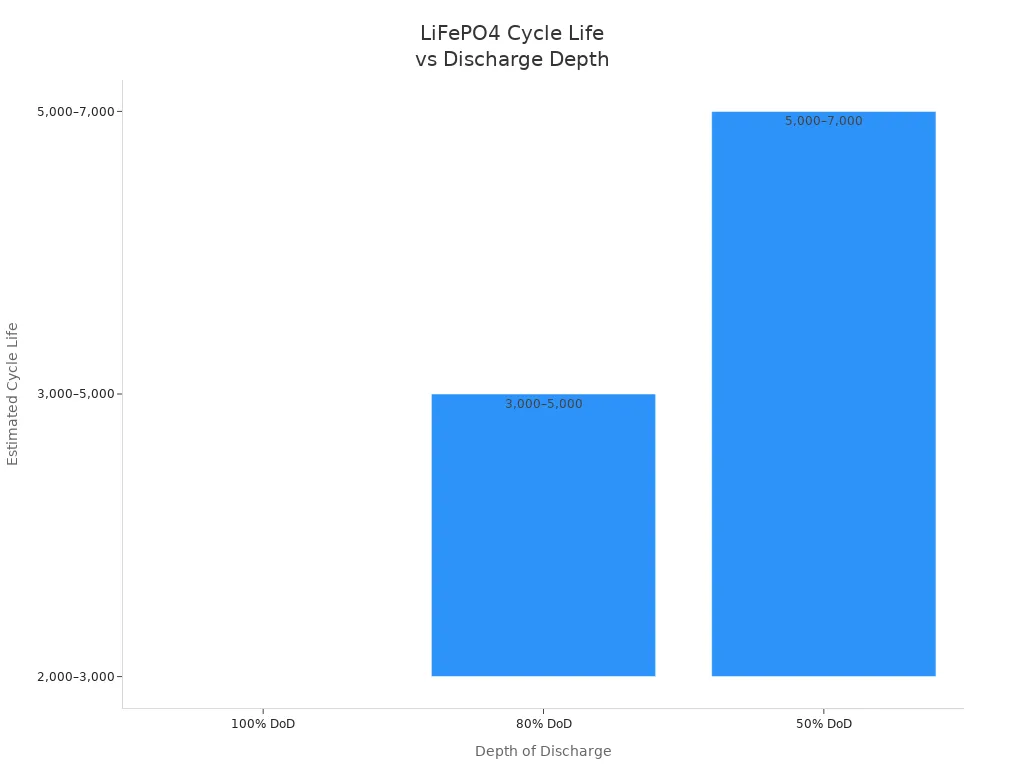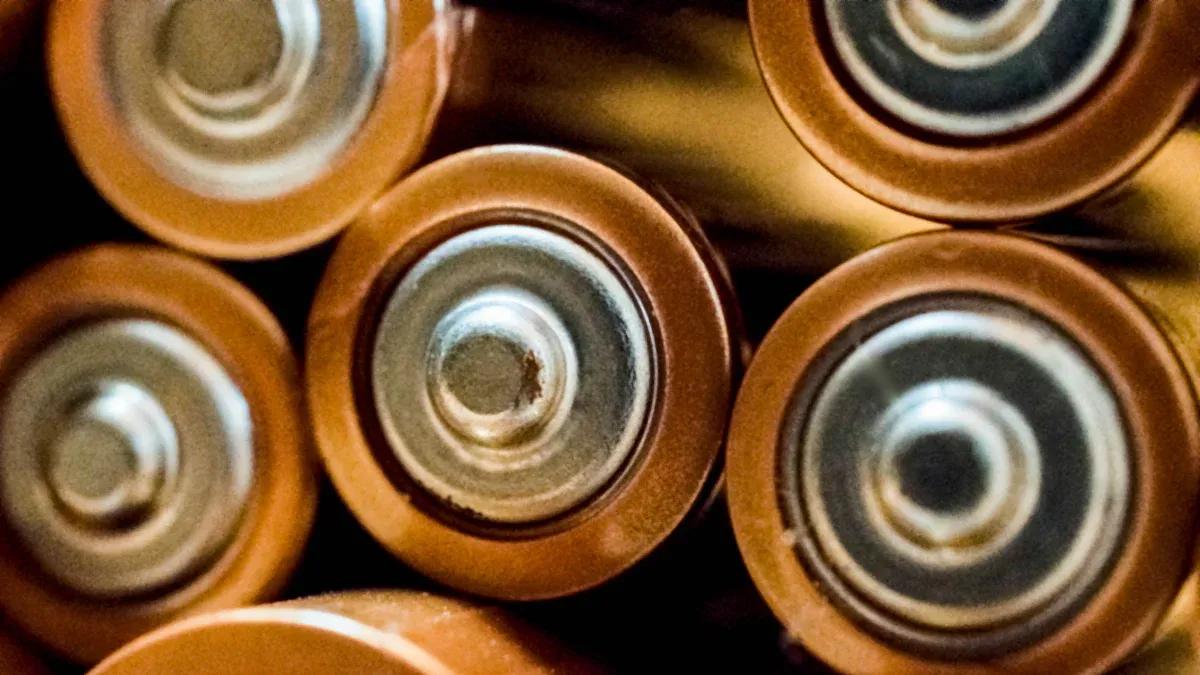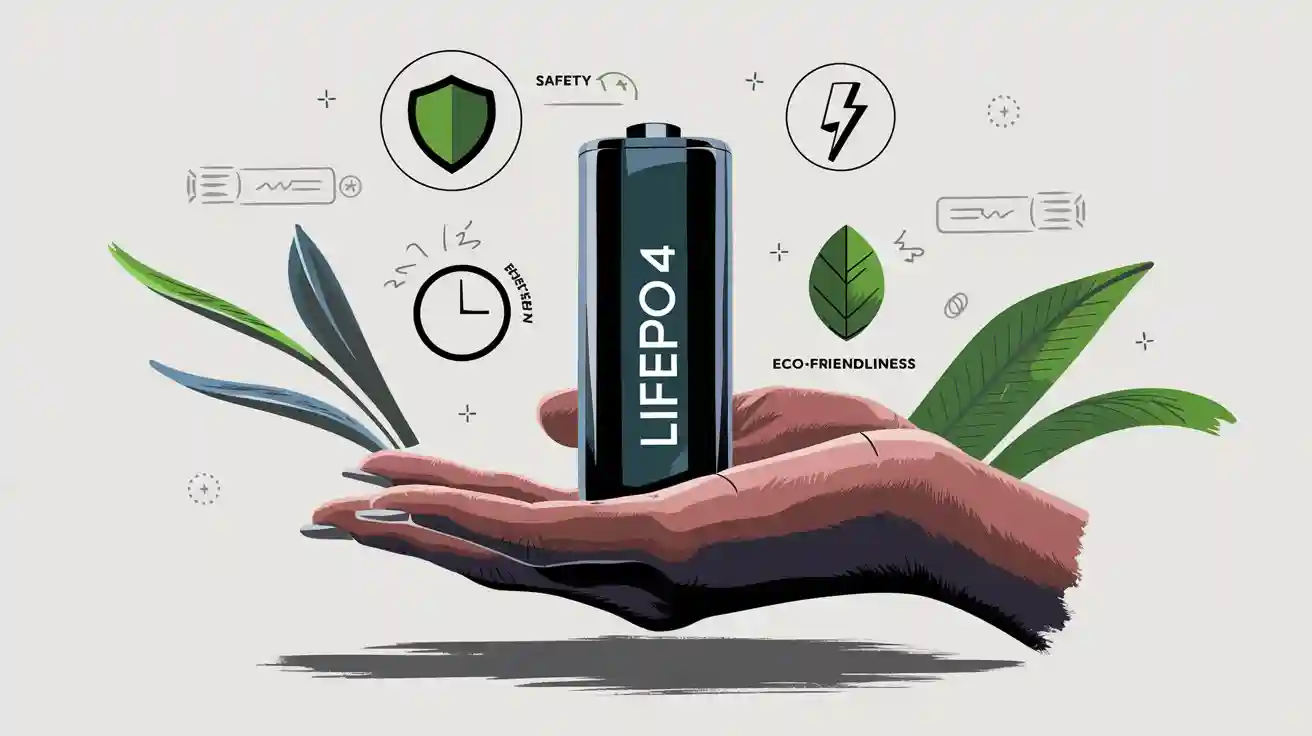What Is a LiFePO4 Battery and How Can It Benefit You?
A LiFePO4 battery uses lithium iron phosphate chemistry to deliver safe and reliable power for many daily needs. You gain longer lifespan, enhanced safety, and lower long-term costs compared to other batteries. You can use LiFePO4 batteries in solar energy storage systems, recreational vehicles, marine equipment, off-grid cabins, emergency backup power, and outdoor gear. These batteries offer consistent performance and simple maintenance. Consider how LiFePO4 technology could support your home, travels, or outdoor adventures.
Key Takeaways
- LiFePO4 batteries last longer than traditional batteries, with over 3,000 charge cycles, saving you money on replacements.
- These batteries are safer due to their stable chemistry, reducing risks of overheating and fires, making them ideal for home and outdoor use.
- LiFePO4 batteries are environmentally friendly, using non-toxic materials and being easier to recycle compared to cobalt-based batteries.
- They perform well in extreme temperatures, maintaining about 80% capacity at 0°C, which is better than many other battery types.
- Choosing a LiFePO4 battery means less maintenance and more reliable power for your solar energy systems, RVs, and electric vehicles.
LiFePO4 Battery Basics

What Is a LiFePO4 Battery
You encounter LiFePO4 batteries in many modern energy storage solutions. A LiFePO4 battery uses lithium iron phosphate as the positive electrode and graphite as the negative electrode. This chemistry gives you a rechargeable battery with high energy density and excellent safety features. The electrolyte, a lithium-salt-based organic solution, allows lithium ions to move efficiently between the electrodes.
- The positive electrode consists of lithium iron phosphate (LiFePO4).
- The negative electrode is typically made of graphite.
- The electrolyte is a lithium-salt-based organic solution that supports ion movement.
Manufacturers design battery modules in rectangular shapes and stack them vertically in standard 19-inch racks. Each module contains several LiFePO4 cells connected in series and parallel. You benefit from a built-in battery management system (BMS) that monitors and controls charging and discharging. This system protects the battery and extends its lifespan.
LiFePO4 batteries stand out because they offer high energy density and a long service life. You can expect thousands of charge cycles, making these batteries a reliable choice for demanding applications. Lithium iron phosphate batteries do not use cobalt, which makes them safer and more environmentally friendly.
How a LiFePO4 Battery Works
A LiFePO4 battery operates by moving lithium ions between the electrodes during charging and discharging. When you charge the battery, lithium ions travel from the cathode (lithium iron phosphate) to the anode (graphite). The ions store energy in the anode. During discharge, the process reverses. Lithium ions move back to the cathode, releasing stored energy and creating an electrical current you can use.
- Charging: Lithium ions move from the cathode to the anode.
- Discharging: Lithium ions return from the anode to the cathode, releasing energy.
You benefit from a consistent voltage range during operation. LiFePO4 batteries typically operate between 2.5V and 3.65V. Staying within this range maximizes efficiency and reduces energy loss. This voltage stability helps the battery deliver reliable power and maintain a long lifespan.
LiFePO4 batteries excel in extreme temperatures. They maintain about 80% of their rated capacity at 0°C, while traditional lithium-ion batteries only reach about 60%. The table below shows how capacity compares at low temperatures:
| Temperature (°C) | LiFePO4 Capacity (%) | Traditional Lithium-ion Capacity (%) |
|---|---|---|
| 0 | 80 | 60 |
You can rely on LiFePO4 batteries for consistent performance in both freezing and high-heat conditions. These batteries resist voltage drops and overheating, which makes them ideal for outdoor and off-grid use. Their high energy density and robust design ensure you get dependable power, even in challenging environments.
Tip: If you need a battery that delivers stable energy density and long-lasting performance, LiFePO4 technology offers a strong advantage over other options.
LiFePO4 Benefits
Longevity and Lifespan
You want a battery that lasts for years and delivers reliable power every day. LiFePO4 batteries stand out for their superior cycle life and long lifespan. When you choose a LiFePO4 battery, you invest in long-lasting energy storage that supports your needs for thousands of cycles.
- LiFePO4 batteries typically reach over 3,000 cycles.
- Some high-quality LiFePO4 batteries can achieve more than 6,000 cycles.
- Standard lithium-ion batteries generally have a lifespan of 300-500 cycles.
This means you can use LiFePO4 batteries for many years before needing a replacement. If you rely on energy storage for solar panels, RVs, or backup power, you benefit from fewer battery changes and lower long-term costs.
The deep discharge capability of LiFePO4 batteries also contributes to their longevity. You can discharge these batteries to a greater extent without causing significant damage. The following table shows how the depth of discharge affects cycle life:
| Depth of Discharge | Estimated Cycle Life |
|---|---|
| 100% DoD | ~2,000–3,000 cycles |
| 80% DoD | ~3,000–5,000 cycles |
| 50% DoD | ~5,000–7,000 cycles |

Tip: Maintaining a depth of discharge below 80% can significantly extend the lifespan of your LiFePO4 battery.
You should avoid discharging LiFePO4 batteries beyond the recommended depth. Doing so can cause irreversible damage. By following best practices, you maximize the value and performance of your energy storage system.
Safety and Stability
Safety features matter when you select a battery for your home, vehicle, or outdoor equipment. LiFePO4 batteries offer robust safety advantages due to their stable chemistry and advanced design.
| Safety Feature | Description |
|---|---|
| Inherent Stability | LiFePO4 batteries have stable chemistry, reducing the risk of thermal runaway. |
| Lower Fire and Explosion Risks | These batteries have a reduced likelihood of fire or explosion compared to other lithium-ion types. |
| Built-in Battery Management System | Ensures overcharge protection, temperature monitoring, and short-circuit protection. |
| Robust Mechanical Design | Features puncture-resistant casing and ventilation systems to safely release gas buildup. |
| Flame-Retardant Materials | Utilizes flame-retardant separators and electrolytes to enhance safety. |
LiFePO4 batteries use lithium iron phosphate, which provides significant safety advantages. The strong phosphate bond enhances thermal stability and reduces the risk of thermal runaway. You benefit from a battery that resists overheating and remains stable even under stress.
You also gain protection from a built-in Battery Management System (BMS). This system monitors charging, temperature, and short circuits, ensuring safe operation. If you use LiFePO4 batteries in demanding environments, you can trust their robust mechanical design and flame-retardant materials to keep you safe.
LiFePO4 batteries respond better to overcharging and physical damage than other lithium-ion batteries. Their stable chemical composition and non-flammable electrolyte make them a safer choice for energy storage. However, you should always use a BMS and avoid overcharging to maintain their safety profile.
Note: While LiFePO4 batteries are safer, incidents can still occur if the battery suffers physical damage or severe overcharging. Proper installation and handling remain essential.
Environmental Impact
You care about the environment and want a sustainable energy solution. LiFePO4 batteries deliver eco-friendly benefits that set them apart from cobalt-based lithium batteries.
| Feature | LiFePO4 Batteries | Cobalt-based Batteries |
|---|---|---|
| Material Abundance | Uses abundant materials like iron and phosphate | Relies on cobalt, which is less abundant |
| Toxicity | Less toxic materials | Contains toxic heavy metals |
| Recycling Ease | Easier to recycle | More challenging to recycle |
LiFePO4 batteries use non-toxic materials such as iron and phosphate. You avoid the environmental risks linked to cobalt, nickel, and other toxic heavy metals. These batteries are easier to recycle, which reduces waste and supports a cleaner planet.
LiFePO4 batteries do not use cobalt, which is often associated with unethical mining practices and environmental harm. By choosing LiFePO4, you support ethical sourcing and reduce the negative effects linked to cobalt extraction. This makes LiFePO4 batteries a responsible choice for energy storage in homes, vehicles, and renewable energy systems.
Callout: LiFePO4 batteries help you lower your environmental footprint while providing reliable, long-lasting energy storage.
LiFePO4 vs Other Batteries

Lead-Acid Comparison
When you compare LiFePO4 batteries to traditional lead-acid batteries, you notice several important differences in performance, safety, and cost-effectiveness. LiFePO4 batteries deliver much higher energy density and longer cycle life. You can charge and discharge a LiFePO4 battery between 3,000 and 8,000 times, while lead-acid batteries typically last only 300 to 600 cycles. This means you replace lead-acid batteries far more often.
| Feature | LiFePO4 Battery | Lead-acid Battery |
|---|---|---|
| Cycle Life | 3,000–8,000 | 300–600 |
| Energy Density | 90–160 Wh/kg | 30–50 Wh/kg |
You also benefit from lower maintenance requirements. LiFePO4 batteries require little to no regular maintenance, while lead-acid batteries need frequent checks, cleaning, and electrolyte top-ups.
| Battery Type | Maintenance Requirement |
|---|---|
| LiFePO4 Batteries | Generally low-maintenance, no regular checks needed |
| Lead Acid Batteries | Require regular maintenance and cleaning |
Although lead-acid batteries cost less upfront, you save more money over time with LiFePO4. You avoid frequent replacements and ongoing maintenance. The total cost of ownership for LiFePO4 batteries is lower because you only need one battery for many years, while lead-acid batteries may need multiple replacements.
- Lead-acid batteries have a lower initial cost.
- LiFePO4 batteries cost more upfront but save you money over time.
- You get better value from LiFePO4 batteries due to their longevity and minimal maintenance.
- Replacing lead-acid batteries several times increases your overall expenses.
Safety is another area where LiFePO4 batteries excel. Lead-acid batteries pose risks such as explosions and hazardous acid spills. LiFePO4 batteries use non-flammable electrolytes and strong metal housings, making them much safer. You avoid leaks, fires, and dangerous chemical reactions. LiFePO4 batteries withstand high temperatures and physical impacts without degrading or causing harm.
Tip: If you want a battery that lasts longer, requires less maintenance, and keeps you safer, LiFePO4 technology offers clear advantages over lead-acid batteries.
Other Lithium Batteries
You may wonder how LiFePO4 batteries compare to other lithium-ion chemistries like NMC (Nickel Manganese Cobalt) and LCO (Lithium Cobalt Oxide). LiFePO4 batteries stand out for their excellent thermal stability and safety profile. You can rely on them in solar storage and off-grid applications where reliability matters most.
- LiFePO4 batteries resist overheating and fire risks better than NMC or LCO batteries.
- LCO batteries provide higher energy density, making them suitable for compact devices, but they have greater safety concerns.
- NMC batteries balance energy capacity and thermal tolerance, often used in electric vehicles.
LiFePO4 batteries last much longer than other lithium-ion types. You get thousands of charge cycles, while NMC and LCO batteries degrade faster. This longevity makes LiFePO4 ideal for long-term use in demanding environments.
LiFePO4 batteries also offer better cost-effectiveness. They use abundant materials like iron and phosphate, which lowers production costs. You spend less over time because you avoid frequent replacements and maintenance.
Note: LiFePO4 batteries combine safety, durability, and cost savings, making them a smart choice for energy storage and high-reliability applications.
Best LiFePO4 Battery for Your Needs
Choosing the best lifepo4 battery for your needs depends on how you plan to use it. You will find lifepo4 batteries in many settings, from home energy storage to electric vehicles. Each application has unique requirements, so you should match the battery’s features to your specific goals.
Home and Solar Use
If you want to store solar energy at home, lifepo4 batteries offer high efficiency and safety. These batteries achieve round-trip efficiencies of 90% or higher, so you get more usable energy from your solar panels. Advanced battery management systems monitor performance and extend lifespan, making them ideal for daily cycling.
Here are some popular models for home and solar storage:
| Battery Model | Voltage | Capacity Options | Certifications |
|---|---|---|---|
| POWERSYNC 48V LiFePO4 Modular Storage | 48V | 48V, 51.2V | UL-1973, CE, IEC62619 & CB, KC BIS, UN3480, Class 9, UN38.3 |
| Simpliphi Power PHI 3.8 | 48V | 3.8 kWh | UN 3480, UL, CE, UN/DOT, RoHS |
| Discover AES LiFePO4 Lithium batteries | 48V | 2.92kWh, 7.39kWh | IEC 62133, UL 1973, UL 9540, UL 2271, CE, UN 38.3 |
| Humless 5kWh BATTERY (LIFEPO4) | 51.2V | 5 kWh | UL 1973 |
| BYD B-Box | 48V | 2.5kWh, 5kWh, 7.5kWh, 10kWh | CE, TUV, UN38.3 |
| BSLBATT 48V Solar Battery (B-LFP48) | 48V | 5kWh, 6.6kWh, 6.8kWh, 8.8kWh, 10kWh | UL1973, CEC, IEC62619, UN38.3 |
| EG4-LifePower4 Lithium 48V Solar Battery | 51.2V | 5.12kWh | UL1973 |
Tip: When selecting a battery for solar, check voltage, capacity, and certifications to ensure compatibility and safety.
RVs, Boats, and Off-Grid
For mobile and off-grid applications, lifepo4 batteries provide lightweight, reliable power. You can expect a long lifespan—3,000 to 5,000 cycles—giving you over 10 years of service. These batteries maintain steady voltage, which protects sensitive electronics in your RV or boat.
| Advantage | Description |
|---|---|
| Long Lifespan | Lasts 3,000 to 5,000 charge cycles, providing over 10 years of reliable service. |
| Stable and Safe Chemistry | Highly resistant to overheating and thermal runaway, ensuring safety in various environments. |
| Consistent Performance | Maintains steady voltage throughout discharge, ideal for sensitive electronics. |
| High Efficiency | Charging and discharging efficiencies exceed 95%, leading to faster charging and more usable energy. |
| Lightweight and Compact | 50–70% lighter than lead-acid batteries, perfect for mobile applications like RVs and boats. |
A lifepo4 battery, such as a 12V 100Ah model, is much lighter than a lead-acid battery. You can install it in tight spaces and carry more gear without sacrificing power. This makes lifepo4 batteries a top choice for common applications for lifepo4 batteries in mobile and off-grid setups.
Electric Vehicles and Tools
You see lifepo4 batteries powering electric vehicles and power tools because of their safety, long life, and efficiency. Manufacturers like BYD and CATL produce advanced lifepo4 cells for these uses.
| Manufacturer | Key Product | Features |
|---|---|---|
| BYD | Blade Battery | High safety, long life, improved volume utilization, increased range |
| CATL | LiFePO4 Cells | Safe, long life, low cost, environmentally friendly, strong R&D focus |
| Ufine | Lithium Batteries | Used in consumer electronics, power tools, high production capacity |
Note: The timing of charging affects battery performance and range in electric vehicles. Allowing a short rest after fast charging can help maintain capacity and extend battery life.
How to Choose the Best LiFePO4 Battery for Your Needs
To select the best lifepo4 battery for your needs, consider these factors:
- Voltage and capacity requirements for your device or system
- Cycle life and expected longevity
- Safety features and certifications
- Size and weight for your installation space
- Operating temperature range
Matching these features to your application ensures you get the most from your investment. Whether you need batteries for home storage, mobile living, or electric vehicles, lifepo4 technology delivers reliable, long-lasting power for common applications for lifepo4 batteries.
You gain several advantages when you choose a lifepo4 battery for your energy needs. Many users report improved performance, quick recharging, and longer operating times. These batteries deliver consistent power, require less frequent recharging, and offer enhanced safety with low risk of overheating. Their long cycle life and low maintenance lead to significant cost savings. The table below highlights why many switch to lifepo4:
| Feature | LiFePO4 Batteries | Regular Lithium-ion Batteries |
|---|---|---|
| Safety | High | Moderate |
| Thermal Stability | Excellent | Poor |
You can rely on lifepo4 batteries for durability, environmental responsibility, and dependable power in daily life.
-

 May.2025.11.24Ternary Lithium Battery vs Lithium-ion: Complete Comparison Guide (2025 Edition)Learn More
May.2025.11.24Ternary Lithium Battery vs Lithium-ion: Complete Comparison Guide (2025 Edition)Learn More -

 May.2025.11.214S2P 18650 14.8V Battery: Complete Technical Guide, Specs, Applications & SafetyLearn More
May.2025.11.214S2P 18650 14.8V Battery: Complete Technical Guide, Specs, Applications & SafetyLearn More -

 May.2025.11.18PCM vs BMS in Lithium Batteries: What’s the Difference and Which One Do You Need?Learn More
May.2025.11.18PCM vs BMS in Lithium Batteries: What’s the Difference and Which One Do You Need?Learn More -

 May.2025.11.17Custom Li-ion Battery Design for Medical Devices (2025 Comprehensive Guide)Learn More
May.2025.11.17Custom Li-ion Battery Design for Medical Devices (2025 Comprehensive Guide)Learn More -

 May.2025.11.17The Future of Lithium-Ion Batteries: Innovation, Sustainability, and Global Market TrendsLearn More
May.2025.11.17The Future of Lithium-Ion Batteries: Innovation, Sustainability, and Global Market TrendsLearn More
















